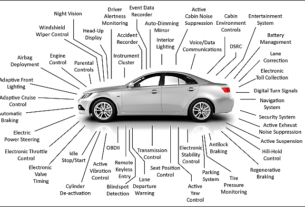The Automotive Open System Architecture (AUTOSAR) is a standardization initiative that aims to establish a common software architecture for automotive electronics. Adaptive AUTOSAR is an extension to the classic AUTOSAR standard that provides a framework for developing complex software systems for the next generation of connected and autonomous vehicles.
Adaptive AUTOSAR:
Adaptive AUTOSAR is designed to provide a flexible and scalable platform for developing automotive software that can support a wide range of use cases, from simple infotainment systems to complex autonomous driving applications. It is based on a service-oriented architecture (SOA) that enables the development of modular and reusable software components.
The adaptive AUTOSAR architecture consists of four layers:
- Infrastructure layer: This layer provides the basic functionality required for adaptive AUTOSAR, such as communication and security services.
- Runtime layer: This layer provides the runtime environment for the software components and handles the interactions between the components.
- Service layer: This layer provides the application-specific services that are required for the software components to interact with each other.
- Application layer: This layer contains the software components that implement the specific functionality of the application.
Benefits of Adaptive AUTOSAR:
- Flexibility: Adaptive AUTOSAR provides a flexible architecture that can adapt to the changing needs of the automotive industry. It allows for the development of complex software systems that can support a wide range of use cases.
- Scalability: Adaptive AUTOSAR provides a scalable architecture that can be tailored to meet the requirements of different applications. It allows for the development of software systems that can be easily customized and extended.
- Reusability: Adaptive AUTOSAR promotes the development of modular and reusable software components. This reduces the development time and cost, as well as the time-to-market for new products.
- Security: Adaptive AUTOSAR provides a secure architecture that is designed to protect against cyber-attacks and ensure the safety of the vehicle occupants.
Challenges of Adaptive AUTOSAR:
- Complexity: Adaptive AUTOSAR is a complex architecture that requires a high level of expertise in software development. It can be challenging for small companies or startups to adopt this architecture.
- Compatibility: Adaptive AUTOSAR is not backward compatible with the classic AUTOSAR architecture. This means that existing software components may need to be re-implemented to work with the new architecture.
- Performance: Adaptive AUTOSAR introduces additional overhead compared to the classic AUTOSAR architecture, which can affect the performance of the software system.
Future of Adaptive Autosar
The future of Adaptive AUTOSAR looks promising as the automotive industry continues to evolve and adapt to new technologies. With the increasing demand for connected and autonomous vehicles, Adaptive AUTOSAR provides a flexible and scalable platform for developing complex automotive software systems.
Here are some potential developments in the future of Adaptive AUTOSAR:
- Integration with AI and machine learning: As the automotive industry continues to adopt AI and machine learning technologies, Adaptive AUTOSAR may provide a framework for developing intelligent systems for autonomous vehicles.
- Standardization: The development of a standardized Adaptive AUTOSAR architecture can lead to the creation of an open ecosystem for the automotive industry, which can enable collaboration and innovation.
- Increased security: With the rise of cyber threats, Adaptive AUTOSAR may provide an enhanced security framework for protecting connected and autonomous vehicles from cyber-attacks.
- Improved performance: As technology continues to advance, Adaptive AUTOSAR may improve its performance, reducing overhead and latency for real-time applications.
- Adoption in other industries: The flexibility of Adaptive AUTOSAR may lead to its adoption in other industries beyond automotive, such as aerospace, rail, and industrial automation.
Overall, the future of Adaptive AUTOSAR is bright, as it provides a foundation for the next generation of connected and autonomous vehicles. With continued development and adoption, it has the potential to transform the automotive industry and enable new and innovative applications.
Conclusion:
Adaptive AUTOSAR is a promising technology that provides a flexible and scalable platform for developing complex automotive software systems. It has the potential to revolutionize the automotive industry by enabling the development of new and innovative applications. However, its adoption may be challenging due to its complexity and compatibility issues. Nevertheless, with the support of the industry, Adaptive AUTOSAR can become the foundation for the next generation of connected and autonomous vehicles.


